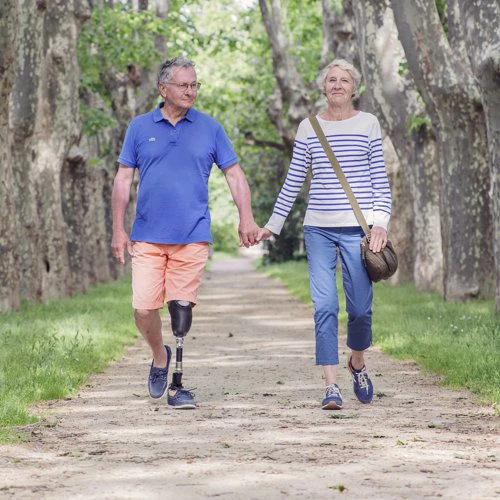Rehabilitation osseointegration
Rehabilitation after osseointegration usually starts a few weeks after surgery, depending on how quickly the bone and tissues around the implant heal.
Recovery varies, but on average it takes 6-12 weeks before the bone implant is fully grown in and you can start using the prosthesis. Only when the implant can be fully loaded is the osseointegrated prosthesis connected and the more intensive part of rehabilitation begins, including gait or use training.
Here, you will learn to use your new prosthesis safely and efficiently. The prosthetists at Amputee Care Center will guide you through the recovery and rehabilitation process and assist you in word and deed. We are there to help you develop a natural way of using and teach you how to take care of the skin around the stoma.
Why choose the Amputee Care Center?
The Amputee Care Center in Belgium specialises and has years of experience in making osseointegration prostheses. Our prosthetists offer personalised solutions for prosthesis wearers from Belgium and the Netherlands considering osseointegration prostheses.
We understand that moving to osseointegration is a big decision. That is why you can come to us for a free, no-obligation introductory consultation. During this meeting, you can ask all your questions about an osseointegration prosthesis over a cup of coffee. We will also analyse your situation, discuss the benefits and risks, and together begin a tailor-made plan.
It is also possible to have your mobility thoroughly evaluated in our prosthesis laboratory. During a (free) gait analysis, you will get a clear picture of whether and how an osseointegration prosthesis could potentially improve your quality of life.
Osseointegration prosthesis costs
At Amputee Care Center, we combine our many years of experience with a personalised approach to provide you with the best possible care. We are here to support you every step of the way. The osseointegration prosthesis costs are usually fully or partially reimbursed by your mutual insurance company or insurance. As ACC, we are a recognised prosthetic supplier and partner of almost all insurers in Belgium and the Netherlands. We can therefore advise you on osseointegration prosthesis reimbursements. We will help you by taking the reimbursement application process off your hands, so that you are relieved of any worries.
Make a free, no-obligation appointment
Would you like to know more about your personal prosthetic options after osseointegration? Then contact us at Amputee Care Center in Genk (Belgium). We are ready to help you with this important step towards a more comfortable and active life. Schedule a free introductory consultation and discover how an osseointegration prosthesis can change your life.






